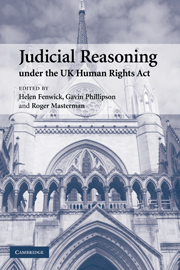Book contents
- Frontmatter
- Contents
- List of contributors
- Foreword
- Preface and acknowledgments
- Table of cases
- Table of legislation
- Table of treaties
- 1 The Human Rights Act in contemporary context
- PART I The interpretation of the Human Rights Act 1998
- PART II The Human Rights Act and substantive law
- 9 The common law, privacy and the Convention
- 10 Judicial reasoning in clashing rights cases
- 11 Family law and the Human Rights Act 1998: judicial restraint or revolution?
- 12 Article 14 ECHR: a protector, not a prosecutor
- 13 Criminal procedure, the presumption of innocence and judicial reasoning under the Human Rights Act
- 14 Concluding remarks
- Index
11 - Family law and the Human Rights Act 1998: judicial restraint or revolution?
Published online by Cambridge University Press: 30 October 2009
- Frontmatter
- Contents
- List of contributors
- Foreword
- Preface and acknowledgments
- Table of cases
- Table of legislation
- Table of treaties
- 1 The Human Rights Act in contemporary context
- PART I The interpretation of the Human Rights Act 1998
- PART II The Human Rights Act and substantive law
- 9 The common law, privacy and the Convention
- 10 Judicial reasoning in clashing rights cases
- 11 Family law and the Human Rights Act 1998: judicial restraint or revolution?
- 12 Article 14 ECHR: a protector, not a prosecutor
- 13 Criminal procedure, the presumption of innocence and judicial reasoning under the Human Rights Act
- 14 Concluding remarks
- Index
Summary
Introduction
The implementation of the Human Rights Act 1998 (HRA) in October 2000 was received with mixed feelings by family lawyers. Whilst for some its implementation promised long-overdue changes in the judiciary's approach to legal disputes concerning the family, many were more cautious. Indeed, there were a number of reasons to anticipate that the passage of the HRA into mainstream family law would not necessarily be easy. In particular, it appeared that two key considerations, particularly pertinent to family law, might exert a restraining influence on its use. First, there was, and still is, considerable opposition to the use of rights-based reasoning in the family law context. Secondly, the legal regulation of family life often gives rise to sensitive questions of public policy, including complex socio-economic considerations, which are traditionally regarded as the responsibility of Parliament rather than the courts. It could thus be anticipated that a combination of these two factors would lead to what has been termed a ‘minimalist’ or conservative approach to the HRA in the family law context.
The purpose of this chapter is not to contend that either judicial conservatism or activism would be the better approach to the HRA. Rather, it is to review the post-implementation case law to determine how, if at all, these two factors have influenced the impact of the HRA on domestic family law. To this end, it focuses on the reasoning employed by the judiciary with respect to these two issues in a number of leading cases.
- Type
- Chapter
- Information
- Judicial Reasoning under the UK Human Rights Act , pp. 308 - 347Publisher: Cambridge University PressPrint publication year: 2007

